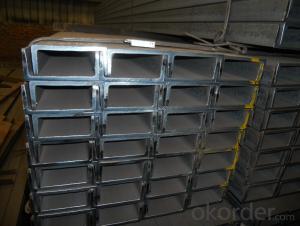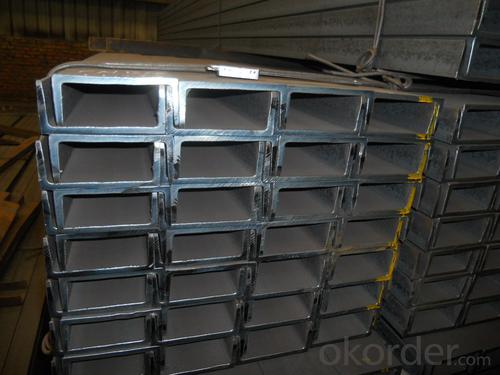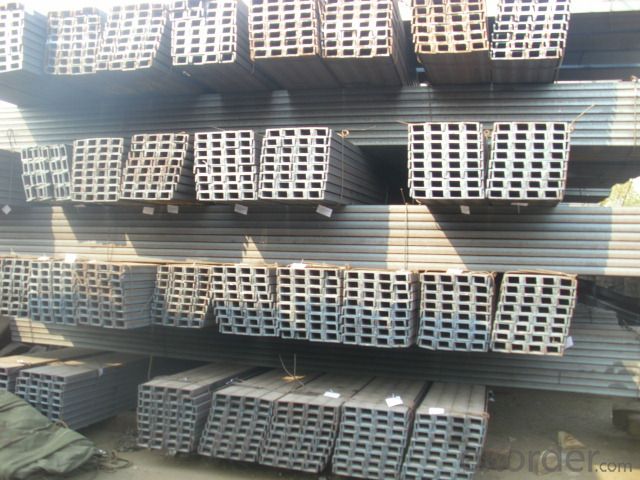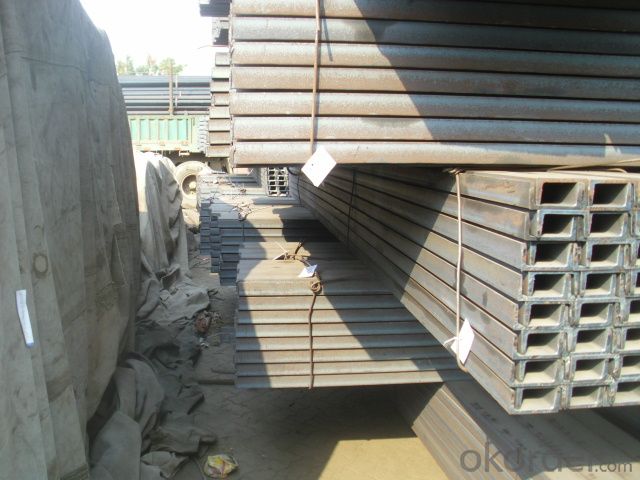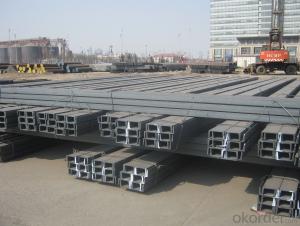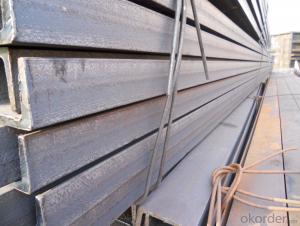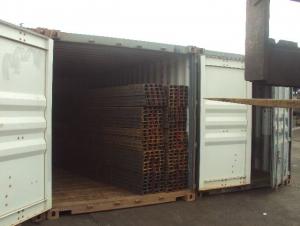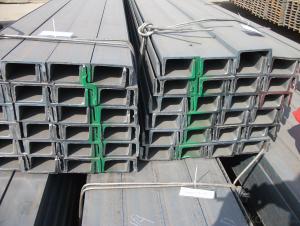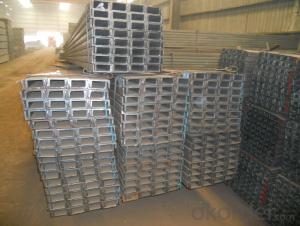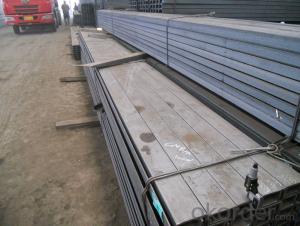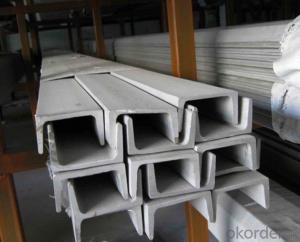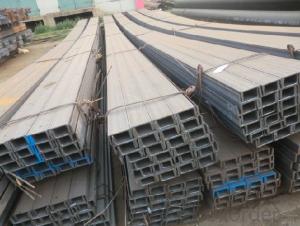U-channel Steel JIS Standard High Quality Hot Rolled
- Loading Port:
- Tianjin
- Payment Terms:
- TT OR LC
- Min Order Qty:
- 25 m.t.
- Supply Capability:
- 2000 m.t./month
OKorder Service Pledge
OKorder Financial Service
You Might Also Like
Product Description:
OKorder is offering U-channel at great prices with worldwide shipping. Our supplier is a world-class manufacturer of steel, with our products utilized the world over. OKorder annually supplies products to European, North American and Asian markets. We provide quotations within 24 hours of receiving an inquiry and guarantee competitive prices.
Product Applications:
1.The JIS channel can be devided into two kinds, namely common channel steel and light channel steel. The sizes of hot rolled common channel steel range from 5# to 40#. Meanwhile, the channel steel can be divided into cold forming sectional equal channel steel, cold forming sectional unequal channel steel, cold forming inner edge channel steel and outer edge channel steel.
2.The JIS channel is usually used for arch-itechtural structure, and they could be welded in order to support or hang a vari-ety of facilities. They are also usually used in combination with I beam. The channel steel with sizes under 14# is usually applied to construction engineering, as purline, while the channel steel with sizes above 16# is more likely to be used in building vehicle chassis structure and mechanical structure. Furthermore, the channel steel in sizes above 30# are target at building bridge structure, as tension bar.
Product Advantages:
OKorder's U-channel are durable, strong, and resist corrosion.
Main Product Features:
· Premium quality
· Prompt delivery & seaworthy packing (30 days after receiving deposit)
· Corrosion resistance
· Can be recycled and reused
· Mill test certification
· Professional Service
· Competitive pricing
Product Specifications:
1.We are able to provide channel steel of top quality at attractive price.
2.Our products of channel steel have passed ISO9001:2008 Quality Management System Certification.
Alloy No | Grade | Element (%) | |||||
C | Mn | S | P | Si | |||
Q235 | B | 0.12—0.20 | 0.3—0.7 | ≤0.045 | ≤0.045 | ≤0.3 | |
Alloy No | Grade | Yielding strength point( Mpa) | |||||
Thickness (mm) | |||||||
≤16 | >16--40 | >40--60 | >60--100 | ||||
≥ | |||||||
Q235 | B | 235 | 225 | 215 | 205 | ||
Alloy No | Grade | Tensile strength (Mpa) | Elongation after fracture (%) | ||||
Thickness (mm) | |||||||
≤16 | >16--40 | >40--60 | >60--100 | ||||
≥ | |||||||
Q235 | B | 375--500 | 26 | 25 | 24 | 23 | |
Note of U-channel
1. According to national standard (GB) for our products, if not, supply according to national standards (GB) or agreement.
2. We can not only provide electric furnace +LF+VD and electros lag re-melting (ESR) steel forging materials, but also forging products of piece, bar, etc.
3. Our company is equipped with roll equipment and can provide our customers with roll billets or finished.
4. The materials that we purchase are all accord with International General Standard; you could check it out on the Material Quality Sheet.
5. We are the creator of the “seven-step inspect method” in China.
6. The technical workers we employed are the ones with many years’ working experience, who know the technology procedures very well.
7. We will strictly inspect our production that we sold according to the customer’s request.
FAQ:
Q1: How soon can we receive the product after purchase?
A1: Within three days of placing an order, we will begin production. The specific shipping date is dependent upon international and government factors, but is typically 7 to 10 workdays.
Q2: What makes stainless steel stainless?
A2: Stainless steel must contain at least 10.5 % chromium. It is this element that reacts with the oxygen in the air to form a complex chrome-oxide surface layer that is invisible but strong enough to prevent further oxygen from "staining" (rusting) the surface. Higher levels of chromium and the addition of other alloying elements such as nickel and molybdenum enhance this surface layer and improve the corrosion resistance of the stainless material.
Q3: How soon can we receive the product after purchase?
A3: Within three days of placing an order, we will begin production. The specific shipping date is dependent
Images:


- Q: Can steel channels be used in electrical applications?
- Electrical applications can indeed make use of steel channels. These channels are frequently employed in electrical installations to offer support and safeguard electrical cables and wiring. They find wide usage in industrial and commercial environments where durability and strength hold significant importance. Usually constructed from galvanized steel, steel channels possess corrosion resistance and ensure a lengthy lifespan. They are simple to install and provide a stable and secure path for electrical cables, effectively preventing damage and maintaining an organized and tidy wiring system. Additionally, steel channels serve as mounts for electrical equipment and components, such as junction boxes or conduits, facilitating easy access and maintenance. All in all, steel channels prove to be a dependable and versatile choice for electrical applications.
- Q: Can steel channels be used in the construction of architectural canopies?
- Yes, steel channels can be used in the construction of architectural canopies. Steel channels are strong and durable, making them suitable for supporting the weight of the canopy structure. Additionally, steel channels can be customized and fabricated to meet the specific design requirements of the canopy, allowing for flexibility and creativity in the architectural design.
- Q: Are steel channels suitable for soundproofing?
- No, steel channels are not typically suitable for soundproofing. While steel channels are often used in construction for structural support, they are not effective in blocking or absorbing sound. Steel is a dense and rigid material that tends to reflect sound waves rather than absorbing them. In order to achieve effective soundproofing, materials with high sound absorption properties, such as acoustic foam or mass-loaded vinyl, are generally recommended. These materials help to reduce the transmission of sound and can be more effective in creating a soundproof environment.
- Q: 10# how much is it per kilogram of channel steel?
- Cold rolling edge channel (CJ/YB99-81 standard standard)The height of =120, legs wide =60, short width =20, thickness =3, leg end arc radius =3.0, cross-sectional area (cm2) =7.808, (kg/m) =6.090 theoretical weight (legs bent inward kind)If the non target is not necessarily.
- Q: What is the square bevel washer used for channel steel?
- The inclination of the channel steel and the angle of the square bevel washer coincide with the standard.
- Q: Is section steel the same as channel steel?
- Channel steel is one of the types of steel, including channel steel, angle steel, I-beam, H steel, L steel, etc..
- Q: What do you mean by "A" in the channel type?
- A thin waist is the most.The width of their legs is equal to the waist thickness difference, that is, the real leg (not including waist thickness) is the same length, and the average leg thickness is the same.
- Q: What are the different finishing techniques for steel channels?
- There are several different finishing techniques that can be used on steel channels to enhance their appearance and protect them from corrosion. One common finishing technique is galvanizing. This involves coating the steel channels with a thin layer of zinc, which provides excellent corrosion resistance. The zinc coating can be applied through either hot-dip galvanizing, where the channels are immersed in a bath of molten zinc, or through electroplating, where an electric current is used to deposit the zinc onto the surface of the channels. Galvanized steel channels have a distinctive silver-gray appearance. Another finishing technique is powder coating. This involves applying a dry powder to the steel channels and then baking it in an oven to create a durable and decorative finish. Powder coating is available in a wide range of colors and can provide a smooth and even coating on the channels. Painting is another common finishing technique for steel channels. This involves applying a liquid paint to the surface of the channels. The paint can be applied through various methods such as brushing, spraying, or dipping. Painting not only enhances the appearance of the channels but also provides a protective barrier against corrosion. In addition to these techniques, steel channels can also be polished or brushed to create a smooth and shiny surface. Polishing involves using abrasive materials to remove any imperfections and create a reflective surface. Brushing, on the other hand, involves using a wire brush or abrasive pad to create a textured finish on the surface of the channels. Overall, there are several different finishing techniques available for steel channels, each with its own advantages and aesthetic appeal. The choice of finishing technique will depend on factors such as the desired appearance, corrosion resistance requirements, and cost considerations.
- Q: How do steel channels contribute to the overall versatility of a structure?
- Steel channels contribute to the overall versatility of a structure by providing a strong and flexible framework that can be easily customized and adapted to different design requirements. They allow for the creation of various structural configurations, such as beams, columns, and trusses, which can be adjusted in length, width, and depth as needed. This versatility enables architects and engineers to design structures with different spans, heights, and load-bearing capacities, making steel channels an essential component in constructing diverse and adaptable buildings and infrastructure.
- Q: What does "channel 160*60*20*2.5" mean in steel roof trusses? What is the specific weight?
- Steel structure is mainly made of steel material, and it is one of the main types of building structure. The structure is mainly composed of steel beams and steel plates, such as steel beams, steel columns, steel trusses and so on. Each component or component is usually connected with welds, bolts or rivets. Because of its light weight and simple construction, it is widely used in large factories, stadiums, super high-rise and other fields.
Send your message to us
U-channel Steel JIS Standard High Quality Hot Rolled
- Loading Port:
- Tianjin
- Payment Terms:
- TT OR LC
- Min Order Qty:
- 25 m.t.
- Supply Capability:
- 2000 m.t./month
OKorder Service Pledge
OKorder Financial Service
Similar products
Hot products
Hot Searches
Related keywords
